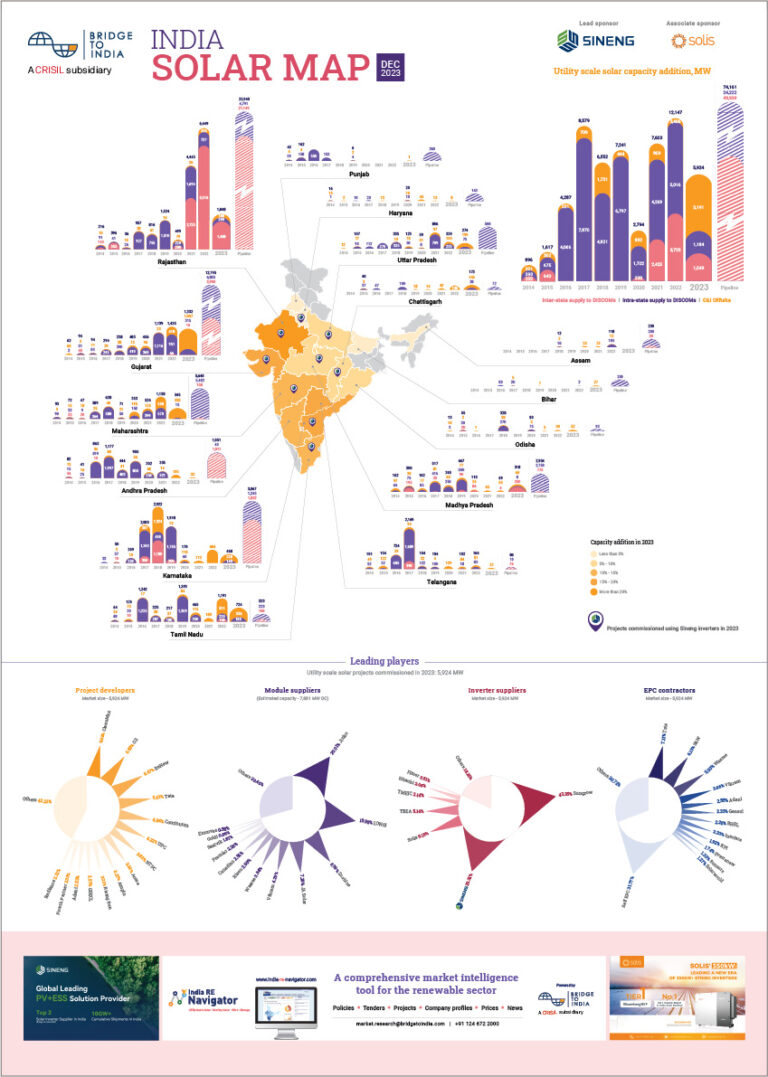As we come to the end of the financial year, a rush to meet allocation and announcement targets has made the Indian solar market fairly frantic. Just last week, bid results were announced for a cumulative capacity of 1,425 MW including a 1,200 MW state allocation in Jharkhand, a 125 MW allocation in Uttar Pradesh by Solar Energy Corporation of India (SECI) and a 100 MW allocation in Rajasthan by National Thermal Power Corporation (NTPC). Apart from that, new tenders were announced for a 750 MW state allocation in Madhya Pradesh and a 100 MW SECI allocation in Chhattisgarh. India’s overall solar project pipeline now stands at a staggering 23 GW.
Key highlights:
- Bid results in Jharkhand show that there is enough appetite in the market to sustain aggressive bidding for every available opportunity
- Bidder interest in NSM tenders in Uttar Pradesh and Rajasthan was muted for specific reasons but the end results are still very aggressive
- BRIDGE TO INDIA expects capacity addition of 4.8 GW in 2016 and over 9 GW in 2017 utility scale projects, making India one of the top global markets
Jharkhand’s 1,200 MW tender was split in two parts – 200 MW was reserved for smaller project sizes between 1-25 MW and 1,000 MW was reserved for larger projects sizes between 26-500 MW. For the smaller projects, winning bids were received in a wide range of INR 5.29 – 7.79/kWh providing attractive returns to developers. For the larger projects, however, winning bids were much more aggressive at INR 5.08 – 5.48/kWh considering that this was an exceptionally large tender for a small state meeting over 90% of its peak consumption and over 20% of its overall power requirement. Further, Jharkhand State Electricity Board has a poor credit risk profile and its credit rating of C+ is ahead of only four other distribution utilities out of a total of 39 rated in the country. The rationale for the state to bring out such a large tender or for the developers to bid so aggressively is unclear to us. But it is clear that there remains strong interest in the market for bidding for every available opportunity.
For the 100 MW NTPC tender in Rajasthan, the three winning bids were in a very close range of INR 5.06 – 5.07/kWh. Given that these projects are under the DCR category, these bids are extremely aggressive, adjusted for higher module cost and risk associated with their availability.
The SECI tender for 125 MW in Uttar Pradesh saw a limited participation from just three companies. IndiaBulls and SolaireDirect won 50 MW and 75 MW at a tariff of INR 4.43 with Viability Gap Funding (VGF) of INR 7.5 million and INR 7.43 million respectively. The limited participation in Uttar Pradesh was primarily due to high solar park costs and concerns about implementation of solar parks (refer).
India’s current solar PV pipeline of 23 GW is divided into 15 GW of tenders where bids have been submitted already and 8 GW of tenders pending bid submission. The Ministry of New and Renewable Energy (MNRE) believes that India would add 12 GW of solar capacity in 2016-17 (refer). However, past experience has shown that there are significant timeline slippages in project implementation particularly in state tenders. BRIDGE TO INDIA’s analysis shows that in the past nearly 40% of projects in state tenders are either significantly delayed or scrapped altogether. Reasons include delays in signing of PPAs, failure in arranging land, transmission and/or financing for projects (refer). BRIDGE TO INDIA estimates capacity addition of 4.8 GW in 2016 and over 9 GW in 2017 excluding additions in the rooftop solar and open access solar markets. That would make India the fourth largest solar market in the world after China, US and Japan in 2016, with a chance of India overtaking Japan in 2017.












